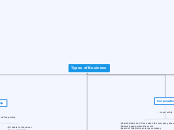Accounting - Unit 1/2
Transactions
DR means Debit, record change on the left side.
CR means Credit, record change on the right side.
Ledger
A group of accounts
Rules for Creating a Ledger
For Capital : You start on the credit side as well.
For all Liabilities : You start on the credit side (right).
For all Assets : You start on the debit side (left).
Trial Balance
A trial balance checks the accuracy of th ledger
DEBITS = THE CREDITS
Types of Business Ownerships
Corporation
Part Owner of higher businesses, you
purchase shares which is a share of
profit the company makes. (Ex; Each share is worth 50 cents, you have 5 shares...you would then have made $2.50)
Disadvantages : If the business isn't
doing well and making no profit,
you're also gaining nothing
Advantages : You only lose the amount
of money you invest.
Partnership
In partnership businesses, you there
is a legal agreement so, if anything
happens you aren't only responsible
and there is equal payment.
Multiple person business
Disadvantages : Profits have to be
distributed.
Advantages : Able to do other things
on the side without worrying. Both are
investing money, which means able o
afford more things. More ideas/pitches.
Sole Proprietorship
Your own business
Disadvantages : Can't afford to be
sick, no holidays, etc. You're also
using your own limited money.
Advantages : You're your own boss and
it's inexpensive.
Accounting Terminology
Balance Sheet
A financial statement that lists
assets, liabilities and owner's equity
on a specific date.
Balance sheets are used to show the
financial position of a business or
even individual on a certain date.
Fundamental Accounting Equation
Owner's Equity = Assets - Liabilities
Assets = Liabilities + Owner's Equity
Equity
The net worth of a person or business.
Liabilities - The debts of a person or
business. (They are listed in a order
they're paid)
Accounts payable (Paid within 30
days), Bank Loan and, Mortgage
Assets - "Items of value owned by a
person or business."
Fixed Assets - Assets that have a long
life. They aren't intended to be sold.
Land (longest life), Building,
Equipment, Automobile
Current Assets - An asset that will be
converted to cash, sold or consumed
within one year.
Cash, Accounts Receivable, Office
Supplies









